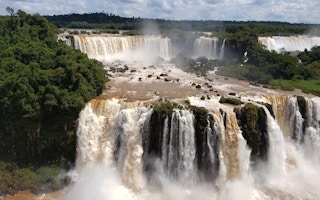The waters of the Xingu River below the Belo Monte hydropower dam, in Brazil’s Amazon, used to flood the river’s forested islands during the rainy season, allowing fish to glide among the trees and gorge on fallen fruit.
But since the controversial dam opened six years ago, the forests no longer flood consistently, and the fish have lost a key place to feed and spawn, local people say.
“Today, these fruits all fall onto dry land, so the fish can’t get the food,” said Josiel Pereira, an indigenous Juruna man from the village of Mïratu, in Pará state.
During the dry season, in turn, the dam sometimes releases too much water at once, drowning sandy beaches and destroying the nests where turtles have long laid their eggs, said Pereira, who is helping scientists understand the ecological impacts of the dam’s construction.
“It has been very difficult for us to survive after the Belo Monte dam development,” he said in an interview. “It has caused a lot of impact on our food, on our source of income.”
Estimated to cost at least 40 billion Brazilian real ($7.6 billion), the Belo Monte hydroelectric complex, the world’s fourth biggest hydropower dam, includes a main dam called Pimental and the Belo Monte reservoir.
“
It’s not true that Belo Monte dam’s energy is clean. Brazilians are paying less for the hydroelectric power energy but the costs are here on the people who live in the Volta Grande.
Mariel Nakane, economist, Socioenvironmental Institute
Harnessing the waters of the Xingu, the dam generated about 5 per cent of all of Brazil’s electricity last year, according to its operator Norte Energia.
But the huge dam complex, vigorously opposed by many indigenous groups in the Amazon, is also changing age-old patterns of seasonally rising and falling water downstream, disrupting the balance of nature and the lives of people who depend on it, scientists and residents warn.
“I feel sad because before I could earn my living, my family’s living, by fishing,” said Pedro Viana, 51, as he sat on the prow of a boat, trailing a fishing net in the abrupt turn in the Xingu known as the Volta Grande, or “Big Bend”, a 130-km (80-mile) stretch of river downstream from the Belo Monte.
“Nowadays, I have to survive by selling farina (manioc flour) and bananas,” said Viana, a member of the local Juruna indigenous community.
Fewer fish
Researchers and indigenous advocacy groups say the Belo Monte complex’s main Pimental dam blocks about 80 per cent of the Xingu’s water, sending it through an artificial channel that feeds the power station.
Currently, the dam sends a maximum of 4,000 or 8,000 cubic meters of water downstream per second in the wet season - the amount alternates each year - and 700 cubic meters in the dry season, according to Norte Energia.
But locals and researchers say that is a fraction of historical water release levels. That has prompted Brazil’s environmental agency Ibama to ask for new studies into the impacts of the dam’s water release levels.
A May 2022 report by researchers from the United States and Brazil, partly funded by Norte Energia, found a nearly 30 per cent reduction in fish species’ “richness, abundance, and functional diversity” and an overall drop in fish sizes in the Volta Grande as a result of the Belo Monte complex’s construction.
Norte Energia has come up with proposals to adjust the amount of water it releases each season, to be considered by the federal prosecutor’s office, which in the past has filed several lawsuits against the company for environmental damage caused by the construction of the dam.
In a statement, Norte Energia said the amounts of water allocated below the Pimental dam were intended to “ensure the ecological conditions of the Big Bend” and create flows that “simulate the natural pulse of the Xingu River.”
In particular, the periods of lowest water release were not below naturally occurring levels in some years, it said.










